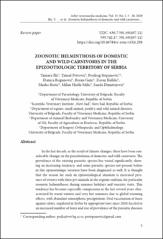| dc.description.abstract | In the last decade, as the result of climate changes, there have been considerable
changes in the parasitofauna of domestic and wild carnivores. Th e
prevalence of the existing parasitic species has varied signifi cantly, showing
an increasing tendency, and some parasitic species not present before
in this epizootiologic territory have been diagnosed as well. It is thought
that the reason for such an epizootiological situation is increased presence
of owners with their pet animals in the regions endemic for particular
zoonotic helminthoses during summer holidays and touristic visits. Th is
tendency has become especially conspicuous in the last several years characterized
by warm winters and very hot summers due to global warming
eff ects, with abundant atmospheric precipitation. Oral vaccination of foxes
against rabies, regulated in Serbia by appropriate laws since 2010, has led to
an increased number of foxes and rise of prevalence of the parasitic diseases for which foxes represent the infection source/reservoir. Continued urbanization
of Serbian cities, with the extension of urban belts into the suburbia
and recreational (“weekend”) settlements, lead to a closer contact of street
dogs and owned dogs with foxes, which results in a signifi cant change in
the parasitic fauna of dogs. It is an additional factor, which in the chain
fox - street dog - owned dog - human increases the risk and tendency for
the occurrence of human infections with zoonotic endoparasites of wild
and domestic carnivores. In order to reliably predict the degree of spread of
particular zoonotic helminthoses in particular regions in Serbia, for which
wild carnivores represent the infection source, it is necessary to institute
continued monitoring of the parasitic fauna in this type of wild animals. | en_US |

